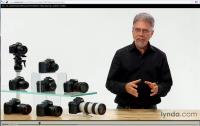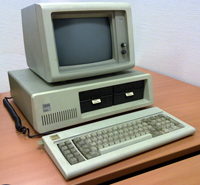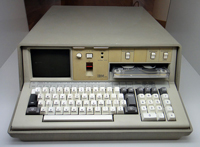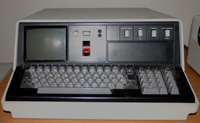Get Ready for Your New Camera Now
Digital cameras have changed the way we think about taking pictures. It used to be that every click of the shutter represented a fixed cost: 50 cents or 75 cents or 1 dollar, depending on the film and lab you used. The more pictures you took, the higher the cost. Today you may replace your camera more frequently but because there's no per-click cost, each picture actually costs less as you take more pictures. Taking more pictures makes you a better photographer, so we're developing a nation of better photographers. There are other ways to become more adept and a series on Lynda.com is one of them.
Three points converge here:
- First, you may already know that photography has a special place on TechByter Worldwide. In part this is because I had a darkroom when I was in high school and Matthew Brady stopped by to help me learn how things worked. (Well, not really.) But I've enjoyed photography as a hobby since the 1960s and spent 10 years as a working professional. Today, it's just a hobby again.
- Second, you may also know that I spend some time most weeks viewing programs that are available on Lynda.com. By way of truth in journalism I should point out that I'm allowed to view these programs without charge. Even so, the per-program fee for programs on the site are reasonable and, if you want to learn about a lot of subjects, the monthly subscription fee is a great value.
- And third, lots of people receive new cameras in December—as gifts or purchased for their own use.
What if you could jump start your knowledge of digital photography techniques that are all but guaranteed to make you a better photographer? Would it be worth a few dollars per month to you?
 If so, let me introduce you to my new best friend, Ben Long, a photographer from San Francisco. He's the author of more than 20 books on digital photography and digital video. He's a writer for Macworld. As a professional photographer, his clients include 20th Century Fox, Blue Note Records, Global Business Network, the San Francisco Jazz Festival, the Pickle Family Circus, and Grammy-nominated jazz musicians Don Byron and Dafnis Prieto. Long has taught at the Santa Reparata International School of Art in Florence (Italy, not Kentucky). He taught a class for imaging engineers at Apple. And he's even written some digital photography utilities that are used by National Geographic, the British Museum, and the White House.
If so, let me introduce you to my new best friend, Ben Long, a photographer from San Francisco. He's the author of more than 20 books on digital photography and digital video. He's a writer for Macworld. As a professional photographer, his clients include 20th Century Fox, Blue Note Records, Global Business Network, the San Francisco Jazz Festival, the Pickle Family Circus, and Grammy-nominated jazz musicians Don Byron and Dafnis Prieto. Long has taught at the Santa Reparata International School of Art in Florence (Italy, not Kentucky). He taught a class for imaging engineers at Apple. And he's even written some digital photography utilities that are used by National Geographic, the British Museum, and the White House.
In other words, he's a pretty smart guy.
But beyond that, Ben Long is one of the best on-screen video instructors I have ever encountered and Lynda.com offers 7 programs from him: Shooting with the Canon 60D (3.5 hours), Shooting with the Nikon D7000 (3.5 hours), Shooting and Processing High Dynamic Range Photographs (5 hours), Foundations of Photography: Black and White (3 hours), Foundations of Photography: Lenses (2.5 hours), Foundations of Photography: Exposure (3.5 hours), and Photoshop CS5: Landscape Photography (nearly 7 hours).
Given my background and experience, there isn't a lot that Ben Long can tell me for the first time but he can remind me of a lot of things that I knew once upon a time. And as a teacher he is excellent. I may have to write him a fan letter.
The programs on shooting with your Canon 60D or Nikon D7000 are examples of Lynda.com's effort to put the presenter in front of a camera more often and for longer periods. The combination of a presenter who is uncommonly comfortable in front of a camera and outstanding production techniques makes these programs interesting, educational, and easy to watch.
That's not an easy balance to achieve.

 If You Have a Digital Camera, You Need Ben Long
If You Have a Digital Camera, You Need Ben Long
It's difficult to earn a 5-cat rating for on-screen recorded instructional programs but I would give this series even more cats if I had them to give. If you're interested in learning more about how to make better pictures with your digital camera, check out this series.
For more information, take a look at Ben Long's classes on the Lynda.com website.
It Seems Like Yesterday ...
... that I was writing about the 20th anniversary of the IBM PC and that it was only a few years before that when I bought my first IBM-compatible PC (from Zenith). In fact, it has been 30 years since the IBM PC hit the market and changed everything. People who are today in their 30s have never known a time without a computer in the house. My two daughters are in this category even though my younger daughter isn't yet 30. I was an early adopter of PC technology.
Thanksgiving is just around the corner and if you're looking for something technological to be thankful for, the personal computer would be a good choice. IBM wasn't the first, despite what they said at the time. Apple had the first commercially viable personal computer and before Apple there was the Altair MITS, a kit computer that did essentially nothing. But it's the personal computer, perhaps more than any other technology, that has enabled and empowered people to do things that otherwise never would have been possible.
 By the time IBM released its version of a personal computer in August 1981, the Apple II had been on the market for several years. So had other computers such as those from Commodore, Atari, and Radio Shack. And of course the Xerox Palo Alto Research Center (PARC) had been experimenting for many years with "desktop" (or under-desk) computers and trying to figure out how a computer the size of a pizza box might be developed. Image from Wikipedia.
By the time IBM released its version of a personal computer in August 1981, the Apple II had been on the market for several years. So had other computers such as those from Commodore, Atari, and Radio Shack. And of course the Xerox Palo Alto Research Center (PARC) had been experimenting for many years with "desktop" (or under-desk) computers and trying to figure out how a computer the size of a pizza box might be developed. Image from Wikipedia.
Even IBM had several precursors to the computer that changed the world.
After 30 years, there's evidence that we are approaching a post-PC world. It isn't here yet and I suspect that a place will remain for desktop computers, just as it has for minicomputers and mainframes. It's all about fitting the tool to the task at hand: Handheld devices are excellent solutions for lightweight computing needs on the go but the desktop computer is still the winner when it comes to substantial projects that involve editing—whether video, audio, or text—graphics, photographic manipulation, and similar tasks. And minicomputers are still good choices for sharing data among large numbers of people. Airline reservation systems and other applications that need extremely high levels of reliability still run on mainframe systems.
But the IBM 5150 personal computer changed our lives.
Before we had personal computers, computers were essentially single-use machines. They performed calculations and that was about it. If you used one, you took your work to the computer, handed it over to a computer operator, and waited for the output to be delivered to you. That's what the PC changed. These machines were general-purpose computers that, depending on what software they were running, could be used to write letters, prepare budgets, and (eventually) to edit images, audio, and video. Functions that would have been impossible or incredibly expensive to perform previously became both possible and inexpensive.
Over the years, personal computers have brought some high-priced functionality to your desktop:
- Typesetting.
- Page layout.
- Publication design.
- Photo editing.
- Audio editing.
- Video editing.
IBM, of course, foresaw the end of the PC era in 2005 and sold the PC business unit to Lenovo just as the company had seen the end of the typewriter market and divested itself of the Selectric business unit while it still had some value.
Before the PC
 When IBM entered the PC market in 1981 the company countered criticism that it had arrived rather late to the party by saying that IBM had been in the "personal computer" business for several years. They cited machines such as the IBM 5100 Portable Computer that the company introduced in 1975. The 5100 ran either APL ("a programming language") or BASIC ("beginners all-purpose symbolic instruction code") and came with 16K to 64K of RAM. The machines were priced between about $9000 and $20,000—hardly in the price range of the average 1975 consumer. In addition to the price, the only applications available for the 5100 were designed for statisticians and engineers.
When IBM entered the PC market in 1981 the company countered criticism that it had arrived rather late to the party by saying that IBM had been in the "personal computer" business for several years. They cited machines such as the IBM 5100 Portable Computer that the company introduced in 1975. The 5100 ran either APL ("a programming language") or BASIC ("beginners all-purpose symbolic instruction code") and came with 16K to 64K of RAM. The machines were priced between about $9000 and $20,000—hardly in the price range of the average 1975 consumer. In addition to the price, the only applications available for the 5100 were designed for statisticians and engineers.
Image from Ask.com.
 In 1978, IBM introduced the 5110 Computing System with software that could be used by businesses for accounting functions: General ledger, accounts receivable, accounts payable, and inventory control. At that time, Digital Equipment Corporation (DEC) was a leader in that market segment with its PDP-11 series of computers. Image from Bit-Tech.net.
In 1978, IBM introduced the 5110 Computing System with software that could be used by businesses for accounting functions: General ledger, accounts receivable, accounts payable, and inventory control. At that time, Digital Equipment Corporation (DEC) was a leader in that market segment with its PDP-11 series of computers. Image from Bit-Tech.net.
A year later, IBM released the 5520 Administrative System, which was arguably the first attempt to produce a general-purpose computer. The 5520 included applications for text processing and storage. Then, in 1980, the 5120 hit the marketplace priced between $9000 and $24,000. Still well outside the price range for home or individual office user, the computer had 32K of RAM and included a fast (120 characters-per-second) printer. Those who bought the 5120 could also purchase applications for inventory, billing, payroll, accounts payable, accounts receivable, and general ledger accounting. In other words, these computers were still essentially competition for DEC's minicomputers.
In 1980 the IBM Office Products Division released a device they had named the "Displaywriter", the company's first desktop word processor.
Purists will insist, perhaps, that the IBM MT/ST was the company's first word processor in 1964: "MT/ST" stood for "Magnetic Tape/Selectric Typewriter" and that tells the tale of how the technology worked. The MT/ST, and later the MT/SC ("Magnetic Tape/Selectric Composer") combined an IBM Selectric typewriter integrated with magnetic recording and playback facilities. The MT/ST's tapes were replaced by floppy disks on the MT/SC. What they typist entered was recorded onto a cassette tape (or floppy) that could later be edited and played back. Later versions had 2 tape drives and could be used for basic mail-merge functions.
At a time when preparing anything for print required typing information and handing it off to a typesetter, the MT/ST and MT/SC machines were a remarkable improvement. Some low-end typesetting jobs (say, for example, a quarterly calendar of events for the State of Ohio's Travel and Tourism Bureau) could be handled by the "cold-type" capabilities of these systems. The jobs still had to be pasted up manually but the process was faster and this was effectively the beginning of the end for small typesetting operations.
But to get back to the Displaywriter: This was a huge improvement over the MT/ST and MT/SC systems. Editing was far easier and the new systems provided the ability to perform advanced editing functions such as indenting text, full justification, centering, and even underlining. Additionally, the Displaywriter contained a spelling dictionary with an astounding 50 thousand words.
A year after that, the 5150 arrived and we've never looked back.
Short Circuits
Changes Coming for G-Mail
Google says 2012 will bring changes to the way G-Mail works and that Google+ will be more important not just for individuals but also for businesses. That's the word from the annual Google Atmosphere conference. More than 300 chief information officers from companies that use various Google products at their companies attended the conference.
G-Mail and Google Apps are where changes are expected. G-Mail currently claims more than 100,000,000 users but not all of those users consider G-Mail to be their primary e-mail application. Google wants to change that.
The goal appears to be tighter integration between Google+, G-Mail, Google Docs, and the Google Calendar, making them more Outlook-like. Currently the various Google offerings aren't particularly well integrated if they are integrated at all. Microsoft, of course, is trying to maintain control of office desktop e-mail, task management, and calendar functions with Outlook and claims to be winning. At this week's conference, Google's head of enterprise business, Amit Singh, said that Google is gaining "thousands" of customers every day.
Also on the agenda is the battle between Google and Facebook. Google has jumped into Facebook's market with Google+ but Facebook hasn't tried its hand (yet) at developing e-mail, calendar, and task-management applications.
Disk Prices to Stay Put: Seagate
If you're used to disk prices dropping every few days, watch out. You may have to wait a while for the next drop. Quite a while. Maybe until 2013. That's the word from Seagate, the second largest disk manufacturer in the world.
Seagate's CEO, Stephen Luczo, says that prices will stay pretty much where they are until at least the end of 2012. The primary cause is severe flooding in Thailand, where about 13 million people homeless. Thailand is a major producer of hard drives and many of the factories that create drives are closed, either because the factories are flooded or because the workers' homes are flooded.
As a result, instead of falling, hard drive prices have been rising. They're up about 20% over the past month.
Getting factories back into operation will take until the end of 2012 according to Luczo and it might take longer. Between now and then, supplies will be diminished and demand is expected to continue to rise.
Seagate’s primary competitors, Western Digital and Toshiba have both lost manufacturing capacity because of the flooding. Predicted demand for drives this quarter is expected to be about 180 million and manufacturing capacity exists only for about 130 million units.
T-Mobile Opts for Google Music Vapor Ware
Cell phone provider T-Mobile is the first carrier to adopt Google Music. Others are expected to join later. T-Mobile offered the first Android phone so the companies have a history of partnership.
Users will be able to purchase tracks through Google Music and have those purchases added to the monthly T-Mobile bill. Some content will be provided without additional charge to T-Mobile customers.
Neither Google nor T-Mobile has been willing to set a date for when the service will actually be available so it's currently in vapor-ware category.
Music played over the T-Mobile network will consume a significant amount of bandwidth and streamed music needs to play back without skips and pauses so there are questions about whether the network is adequate to handle the load. The load could be substantial if T-Mobile's claim that three quarters of its users have smart phones is correct. (I'm in the 25% that doesn't.)
AIM Gets a Facelift
Does anyone still use AOL's instant-messaging software? Lots of people use AIM but everyone I know uses somebody else's software to communicate with and through AIM -- Trillian and Pidgin are probably the top choices but many others exist. This makes a difference to AOL because if you're not using AOL's IM client, AOL can't serve you advertisements.
In addition, services such as Facebook and Twitter have eroded AIM's market share so AOL is giving its application new features and the company released a preview version this week.
If you use multiple devices, you'll be able to synchronize your messages and responses between them. The new application also makes it possible for users to show each other photos or videos instead of just linking to them.
AIM dates back to 1997 and the interface hasn't changed a lot since then. Because so many other options are available for messaging (including a competing service from Google), AIM traffic has been dropping. AOL now allows sending and receiving messages to those other networks but the overall number of instant-message users has fallen by nearly one third in the past year. (Source: ComScore.)


 The author's image: It's that photo over at the right. This explains why TechByter Worldwide was never on television, doesn't it?
The author's image: It's that photo over at the right. This explains why TechByter Worldwide was never on television, doesn't it?
